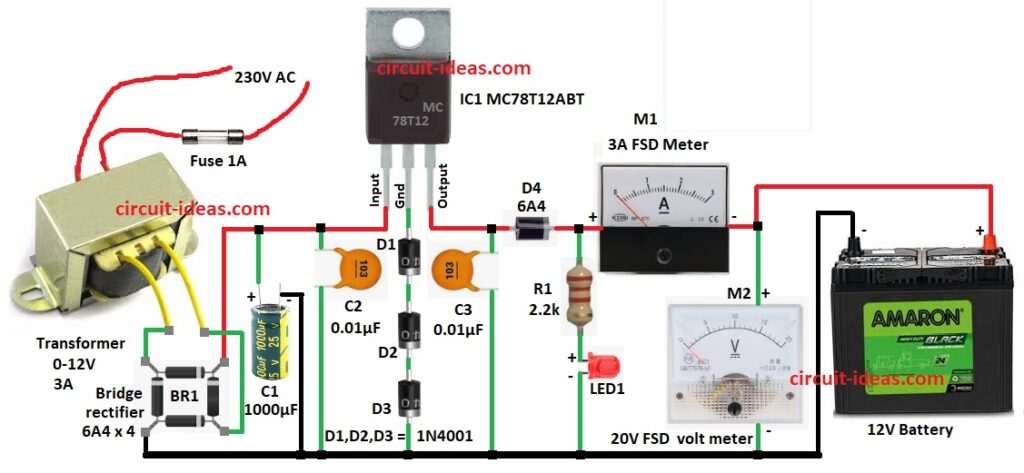Car battery charger help car run good by keeping battery charged.
This simple circuit uses MC78T12ABT IC which works well.
IC is strong and handles high current.
Made by Freescale like 7812 in TO-3 case with max 3A.
Car Battery Charger Circuit using IC MC78T12ABT is made for 12V lead acid battery which can check current and voltage.
Circuit Working:

Parts List:
| Component | Quantity |
|---|---|
| Resistor | |
| 2.2k 1/4 watt | 1 |
| Capacitors | |
| Ceramic 0.01µF | 2 |
| Electrolytic 1000µF, 25V | 1 |
| Semiconductors | |
| IC MC78T12ABT | 1 |
| IC ground diode 1N4001 | 3 |
| Output Diode 6A4 | 1 |
| Bridge rectifier diode 6A4 | 4 |
| LED Any 5mm 20mA | 1 |
| Ammeter 3A FSD | 1 |
| Voltmeter 20V FSD | 1 |
| 0-12V primary, 230V and 3A secondary step-down transformer | 1 |
| Battery 12V | 1 |
In this circuit the AC 230V from wall goes to transformer voltage which drop to safe level.
Transformer gives 15V 3A from secondary winding.
This 15V goes for more processing.
Bridge rectifier BR1 change AC to DC.
Output is bumpy DC, so big capacitor C1 1000µF 25V smooth it.
Smooth DC goes to IC1 MC78T12ABT and it keep voltage steady at 14.1V.
To get 14.1V the ground pin is raised by 2.1V using diodes D1, D2, D3.
So 12V + 2.1V = 14.1V output.
Output goes to battery through diode D4 and it stop backflow if power is OFF.
R1 and LED1 show battery is charging.
M1 is the ammeter which show charging current.
M2 is the voltmeter which show battery voltage.
Formulas:
To make our own car battery charger with IC MC78T12ABT use these formulas:
Filter Capacitor (C1):
Ripple voltage (∆V) = I / (f × C)
where:
How to Build:
To build a Car Battery Charger Circuit using IC MC78T12ABT follow the below mentioned steps for connections and assembling:
- Put all parts as shown in circuit diagram.
- Connect capacitor C2 from input pin of IC1 MC78T12ABT to GND.
- Positive side of C2 goes to input pin and negative to GND.
- Bridge rectifier BR1 connect one pin to 0V-12V transformer wire
- Bridge rectifier BR1 connect second pin to IC1 input pin
- Bridge rectifier BR1 connect third pin to GND
- And bridge rectifier BR1 connect fourth pin to second transformer wire
- Connect fuse F1 to 230V AC input.
- IC1 GND pin goes through D1, D2, D3(in series to GND.
- IC1 output pin connect to C3 and to GND.
- Diode D4 from IC1 output pin stops reverse current.
- Resistor R1 and LED1 in series connect from output pin to GND which shows charging.
- Connect meter M1 ammeter from output pin.
- Connect meter M2 voltmeter from output pin to GND.
- Output pin of IC1 goes to +12V battery positive.
- Battery negative goes to GND.
Conclusion:
This Car Battery Charger Circuit using IC MC78T12ABT is cheap and reliable circuit.
It gives steady charge and stops reverse current.
Meters ammeter and voltmeter help check charging.
It is easy design with common parts and is good for DIY lovers.
Leave a Reply